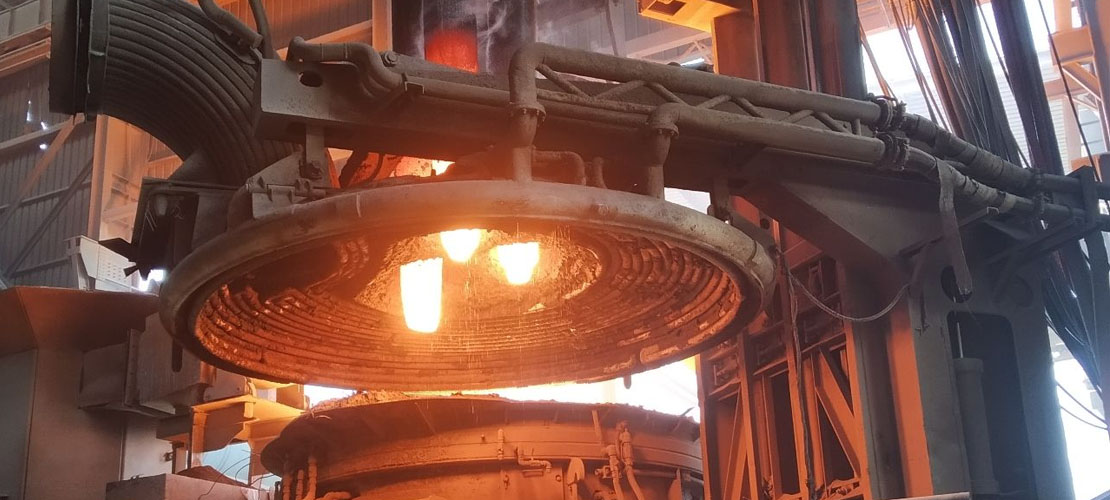Apr. 04, 2025

An electric arc furnace has three electrodes, each supported by an electrode arm. The electrode arm consists of an arm body, a gripper, and a conductive copper tube for transmitting high current. The main function of the electrode arm is to support and hold the electrode. Its structure is a hollow box-type structure welded from steel pipes and steel plates.
Due to the electrode cross arm operating in a strong magnetic and electric field environment, it generates eddy currents and generates heat during operation. Therefore, reinforced ribs and water cooling are employed internally. The cross arm is also equipped with conductive copper tiles connected to conductive copper tubes. Cooling water is passed through the copper tiles and copper tubes to cool the conductive copper tubes and copper tiles. The conductive copper tubes and electrode clamps must maintain good insulation with the non-current-carrying mechanical structure of the cross arm to prevent the furnace body from becoming charged.
The latest development in electrode arm manufacturing technology involves the use of copper-steel composite plates or aluminum to manufacture conductive arms. This not only reduces impedance and conserves electrical energy, but also lightens the weight of the electrode arm, thereby reducing the maintenance workload on copper tubes.
The function of the electrode holder is to clamp or loosen the electrode, and to transmit the current and voltage delivered by the short net to the electrode. The electrode holder consists of several parts, including the front collet, conductive copper tile, connecting rod, stack spring, and hydraulic cylinder.
The tension of the spring clamps the electrode, and the force generated by the hydraulic cylinder compresses the spring in the opposite direction to release the electrode. It is characterized by easy operation and low labor intensity. The collet can be made of copper or steel.
Copper clamps have good conductivity and low resistance, but poor mechanical strength and a high expansion coefficient. Steel clamps have high strength, but high resistance and increased electrical loss. If non-magnetic steel is used to make clamps, electromagnetic loss can be reduced.
Water cooling is required in the middle of the collet to ensure sufficient strength, reduce expansion, and also serve to reduce oxidation and lower resistance. The electrode collet is fixed on the cross arm, and the front collet does not have a conductive function.
The electro-copper tile is connected to the conductive copper tube and the cross arm, with insulating material (HP-5) between the tile and the cross arm. The tile is connected to the conductive copper tube using non-magnetic stainless steel bolts, and the material of the tile is TU2 oxygen-free copper.
Each column is constrained by several guiding rollers, which are divided into front and side guiding rollers. Each guiding roller can be adjusted to ensure the verticality of the column relative to the cradle plane, with a verticality requirement of less than 0.5/1000. The verticality of the column is achieved through the adjustment of both front and side guiding rollers. The spacing between electrode cross arms is adjusted through the adjustment of side guiding rollers.
In practical operations, the adjustment strength of the guide should be moderate. If it is too tight, the screw of the guide roller will be subjected to excessive force, leading to a shortened lifespan of the screw. If it is too loose, it will fail to provide a securing effect on the column, resulting in increased vibration of the horizontal arm during production and potential accidents.
The electrode adjustment system primarily comprises: a column, a column guide mechanism, and an electrode adjustment cylinder. Its primary functions are to facilitate electrode lifting and lowering operations and to maintain balance in the three-phase load power supply during the smelting process. Based on the three-phase impedance, the dynamic voltage signal obtained from the transformer's secondary Rogowski coil is fed back to the PLC, which then issues commands to adjust the servo valve for electrode adjustment. This process aims to optimize power supply and achieve balance in the three-phase load. To adjust the length of the electric arc, the electrode should be able to lift and lower flexibly.
Therefore, the electrode lifter must meet the following requirements:
(1) The electrode can be flexibly raised and lowered, with low system inertia, fast startup and braking, and good rigidity.
(2) The lifting response should be sensitive. Otherwise, it is easy to cause an excessive short-circuit current, leading to automatic tripping of the high-voltage circuit breaker.
The electrode adjustment cylinder is a single-acting plunger cylinder, which descends by its own weight.
Previous: Electric Arc Furnace Bus Bar System
Latest News
Electric Arc Furnace Bus Bar System
Apr. 06, 2025
Electric Arc Furnace Electrode Arm and Adjustment System
Apr. 04, 2025
Latest Products
Customized metallurgical machinery and equipment range: Electric Arc Furnace, Submerged Arc Furnace, LF Refining Furnace, Vacuum Furnace, Induction Furnace, Dust Remove System, Water Treatment Equipment, etc. Providing the most advanced equipment integration services, metallurgical equipment can be customized according to different needs of customers, and production capacity can be adjusted according to customer requirements.
Electric Arc Furnace
Submerged Arc Furnace
LF Refining Furnace
VD / VOD Vacuum Refining Furnace
Induction Furnace
Furnace Accessories
Navigation
E-mail: anna@srfurnace.com
Tel: +86 159 2955 5868
WhatsApp: +86 159 2955 5868
Add:
Room 102, Building 7A, Free Trade Xintiandi, Fengdong Avenue, Fengdong New Town, Xi'an City, Shaanxi Province
